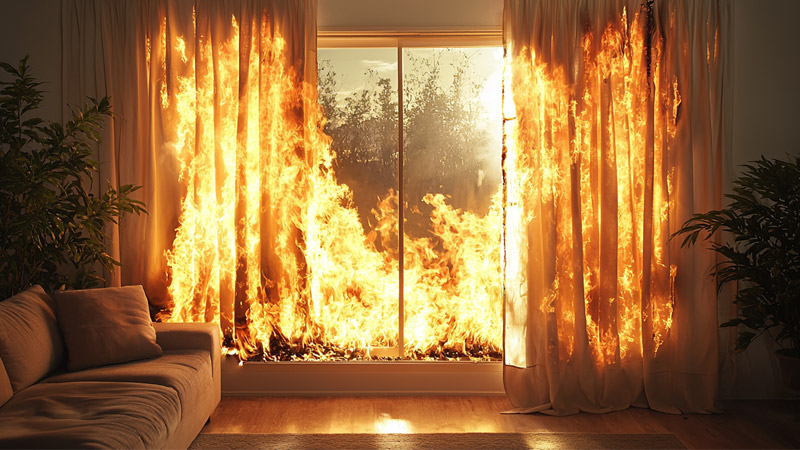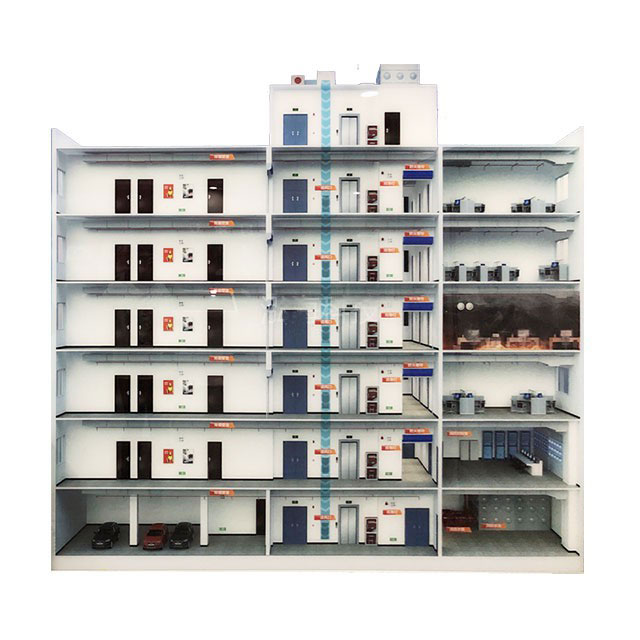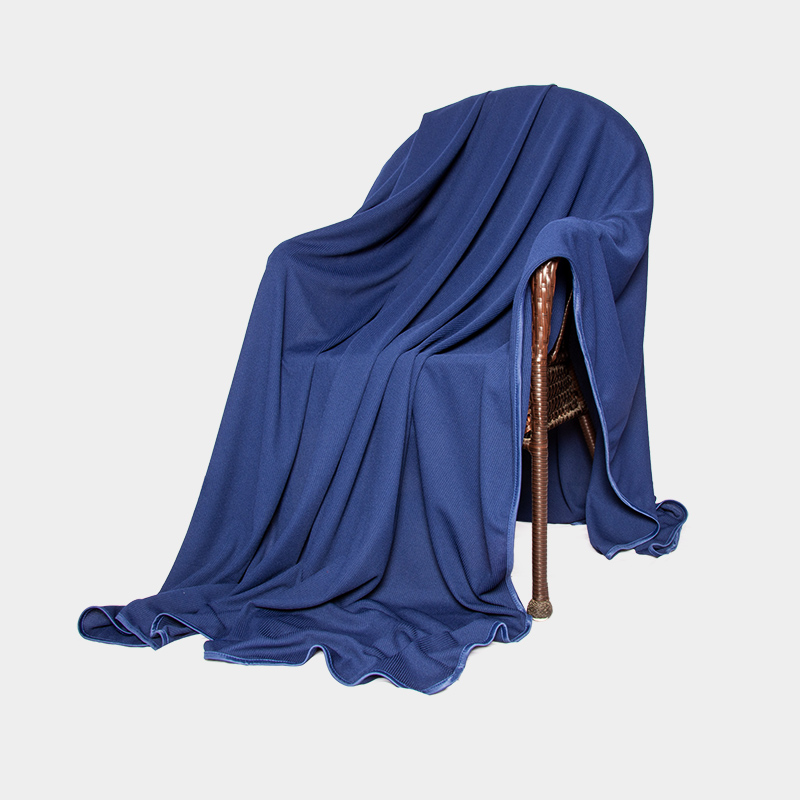These hidden dangers at home can increase the risk of fire by 10 times! Have you ever ignored them?

With dry weather and rising fire risks, fire safety has become a key focus in daily life. According to relevant data, household fires are the leading cause of fires overall. In recent years, frequent household fire incidents have been devastating, prompting more people to pay attention to fire safety within their homes.
This article introduces common but often overlooked fire safety hazards in the home and discusses important fire prevention tips. It also highlights some useful fire safety products and flame-retardant items, including smoke detectors, fire extinguishers, flame-retardant curtains, and flame-retardant fabrics. These products can help reduce the risk of fire in the home and ensure the safety of family members.
Especially in certain areas of your home, which are highly flammable:
Bedroom
- CurtainsMany people decorate their curtains with string lights for aesthetic purposes. However, light bulbs generate heat during use, and when they come into contact with flammable curtains, they can easily ignite a fire.
Additionally, this decoration method not only risks the curtains catching fire but also carpets and bed linens.
Suggestion: To improve safety in your home, choosing flame-retardant curtains can help reduce fire risks. - HeatersIn cold weather, many people use electric heaters for warmth.
If these heating devices are covered with flammable materials, there is a danger of fire.
Suggestion: When using electrical heating devices, always clear the surrounding area of combustible materials. - Bedside Outlets
Many people place outlets near their beds for convenience in charging devices. However, since bedding is highly flammable, this is very dangerous.
Suggestion: Keep charging devices away from combustible materials when using them. - Electric Blankets
As a common heating device, electric blankets should never remain plugged in when not in use.
Otherwise, if the blanket overheats, it could ignite surrounding materials. - Smoking in Bed
Lit cigarettes are an open flame, and if the smoker falls asleep before the cigarette is finished, the dropped cigarette butt could start a fire.
Living Room
- Household Appliances
Some household appliances have their power switches on the secondary coil of the transformer. If the plug is left in for a long time, it could cause a short circuit or carbonization, leading to a fire. - Aging Outlets
Statistics show that about 30% of fires in the past decade were caused by outlets, with outdated outlets being the most dangerous. These have now been banned from sale in many regions.
Also, some households rarely clean dust and hair from power strips, and over time, this accumulation can lead to a short circuit, causing a fire. - Overloaded Circuits
Overloading circuits can accelerate wear and tear, which increases the risk of fire.
Suggestion: Make it a habit to turn off electrical appliances when not in use and avoid using multiple high-power devices simultaneously (e.g., electric kettles, hair dryers, microwave ovens).
For high-power appliances like air conditioners and water heaters, it’s best to use a separate outlet to prevent overloading and potential fires. - Overcharging Devices
With more and more rechargeable devices in daily life, overcharging has become a fire hazard.
Suggestion: Never leave charging devices unattended and always use the appropriate charging equipment to prevent fires.
Kitchen
- Stovetops
When cooking or boiling water, if left unattended, overflowing food or water could extinguish the flame and cause a gas leak, potentially leading to a fire.
For families with elderly or forgetful members, it’s recommended to buy gas stoves with spillover protection to prevent gas leaks caused by accidents. - Grease Build-up
Kitchen grease and long-uncleaned exhaust fan ducts could become the source of a fire.
Suggestion: Keep the kitchen clean and tidy to prevent the breeding of pests like cockroaches and to reduce fire risks. - Gas Pipes
Gas pipes should be regularly inspected, and any signs of aging or wear should be addressed promptly to avoid gas leaks. - Clutter
Many people habitually store miscellaneous items and uneaten food in the kitchen. Since this is also a place that frequently uses open flames, storing items here can easily lead to a fire.
Bathroom
- Exposed Outlets
Some families install outlets at lower positions for aesthetic reasons, but this poses safety hazards. If water is accidentally splashed onto the outlet while cleaning, it can lead to an electrical short.
Moreover, if the bathroom outlets remain exposed for long periods, the high humidity and steam from showers can also cause short circuits. - Heated Towel Rack
Prolonged use of a heated towel rack can trigger accidents, and water droplets on the rack can cause explosions due to the temperature difference between the inside and outside.
Firefighting Tips:
- Always Have a Fire Extinguisher
Keep a fire extinguisher at home. - Use Flame-Retardant Fabrics
Use flame-retardant textiles for commonly used household items. - If You Don’t Have a Fire Extinguisher at Home
You can try the following methods to put out a fire:- Oil Fires: Cover the pan with a lid to extinguish the flames.
- Electrical Fires: Cut off the power, then stand to the side of the appliance and use a fire blanket or quilt to smother the fire.
- Gas Stoves (Natural or LPG): First close the valve, then cover with a damp apron, clothing, or blanket to extinguish the flames.
If the fire becomes uncontrollable, evacuate immediately.
Smoke is the Most Dangerous Part of a Fire
When a fire occurs, the initial cause of injury is often not the flames themselves but the smoke.
Statistics show that more than one-third of fire-related deaths are directly caused by smoke inhalation. Many victims succumb to suffocation from inhaling excessive smoke, preventing them from escaping the fire.
A TV program once used a “high-rise fire smoke simulator” to demonstrate the movement of smoke:
In the simulator, it was observed that if a fire started in the left apartment on the first floor, smoke would quickly spread to the staircase due to an open fire door on the right side.
- 3 seconds: Smoke fills the second floor.
- 5 seconds: Smoke reaches the top floor (4th floor).
- Less than 10 seconds: Smoke has filled the entire floor.
As shown, if fire doors are not closed, smoke can fill an entire floor every 5 seconds. For a high-rise building of 100 meters, smoke can reach the top floor in just 30 seconds. The speed of this smoke diffusion is alarming.

Therefore, in addition to securing your own home, it’s vital to ensure that the fire doors in the hallways of your building remain closed. In the event of a fire, these doors can help block smoke from spreading. If there are no fire doors in your building, evacuate as soon as you notice smoke, before it becomes too dense to escape.
Fire Escape Tips:
- Don’t Swallow, Only Spit: During a fire, spit out saliva instead of swallowing, as this helps keep your respiratory tract clear.
- Stay Close to the Ground: Smoke rises, so stay as low as possible to avoid inhaling too much.
- Use a Wet Cloth: Fold a wet towel into four layers and cover your nose and mouth.
- Don’t Use the Elevator: In a fire, avoid using elevators.
- What to Do if Your Clothes Catch Fire: Don’t panic or run. You can roll on the ground or use thick clothes to smother the flames.
Additional Note: Avoid Storing Items on the Balcony.
In many household fire cases, residents use the balcony to escape. If your balcony is used as a storage area, it can obstruct your escape route and may even be the origin of the fire. It’s also advisable not to completely seal your balcony. Even if installing security bars, make sure they have locks, and inform your family about where the keys are kept. In the event of a fire, this will provide a “safe exit.”









